How Does a Port Build Influence? Diffusion Patterns in Global Oil Transportation
Abstract
:1. Introduction
2. Literature Review, Research Background, and Motivation
3. Data and Modelling Approach
3.1. Data for Global Oil Transport Network
3.2. Port Influence Diffusion Model
4. Modelling Application to the Port Case Study
4.1. Ports with Significant Influence and Continuous Growth

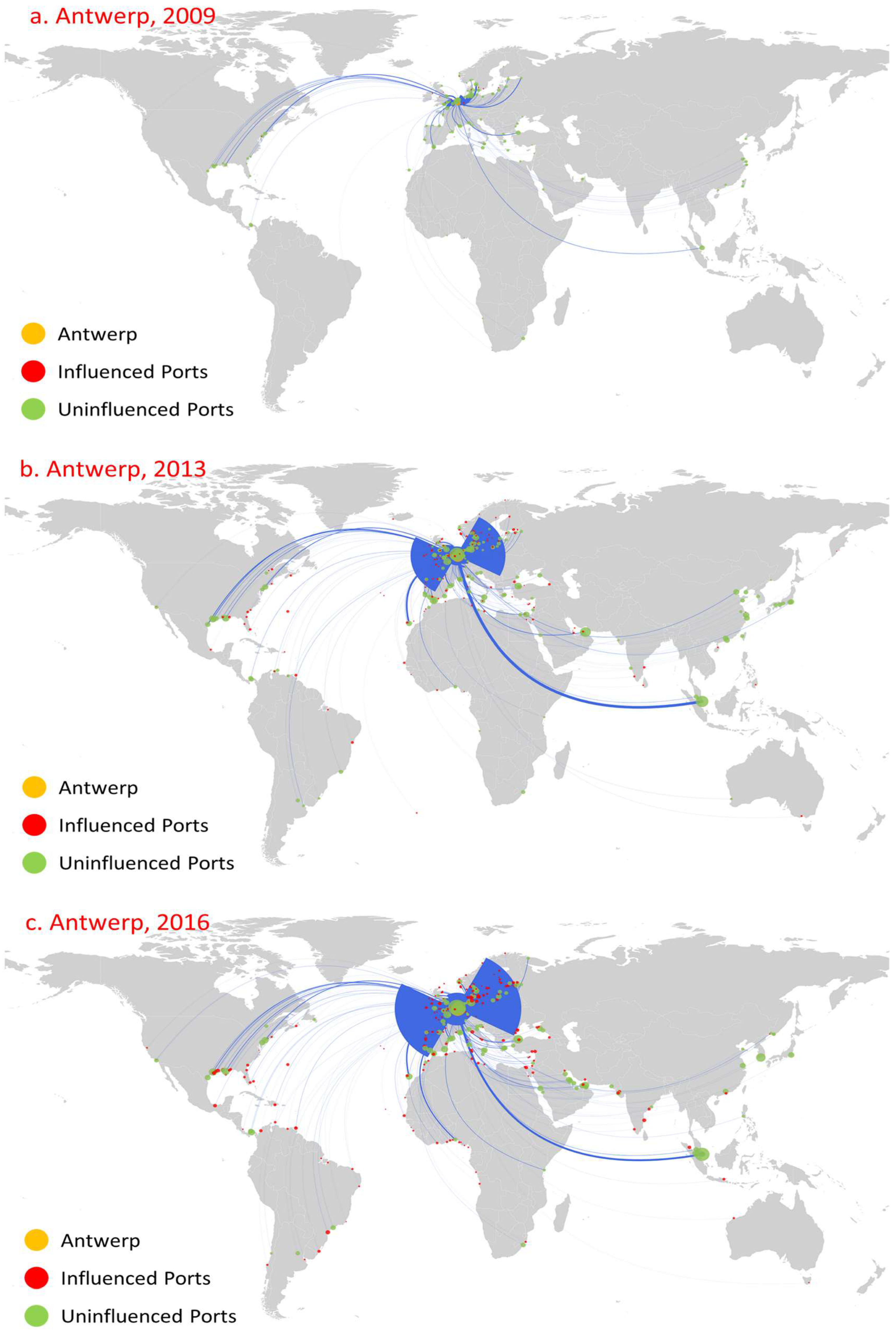
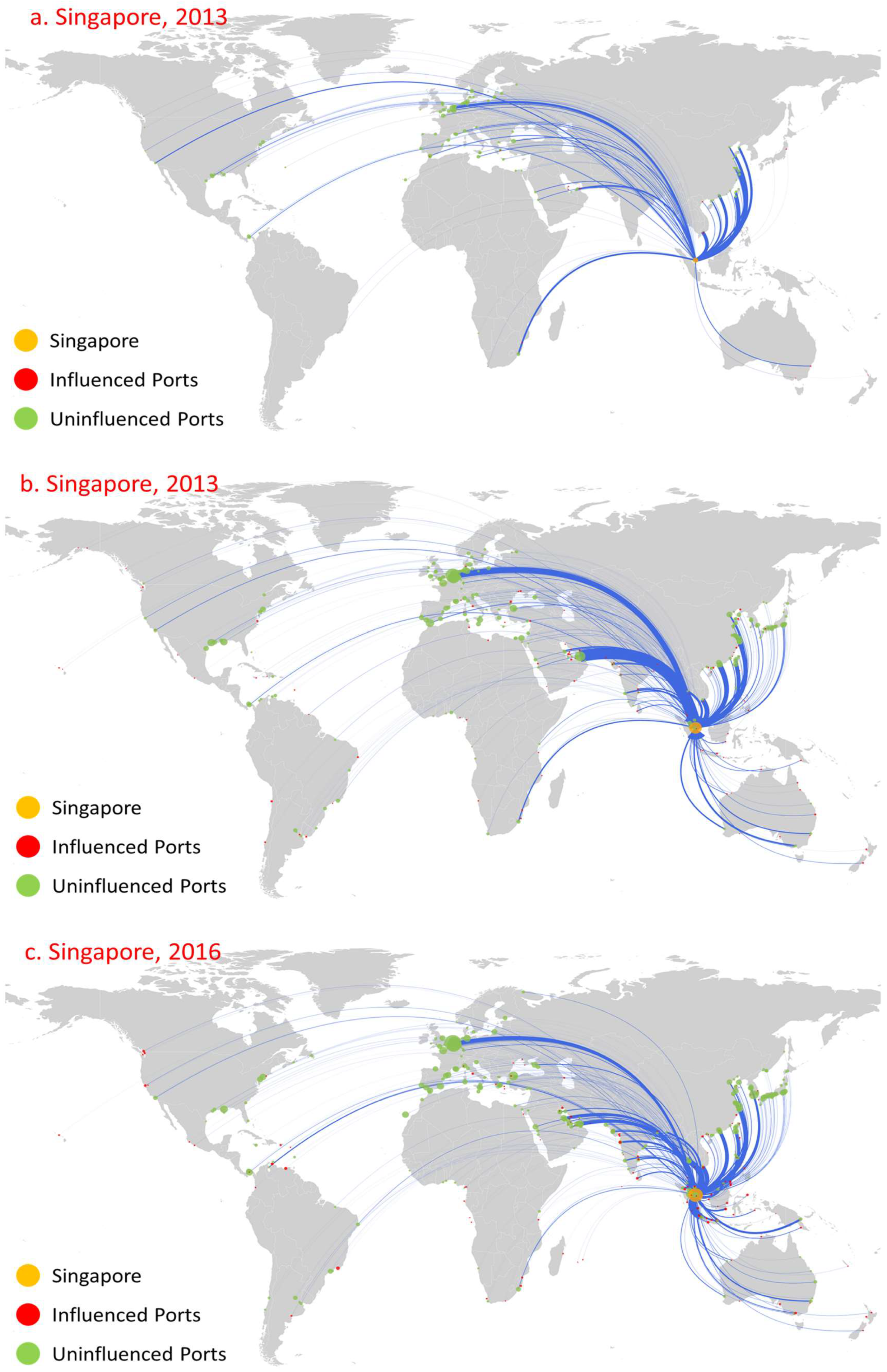
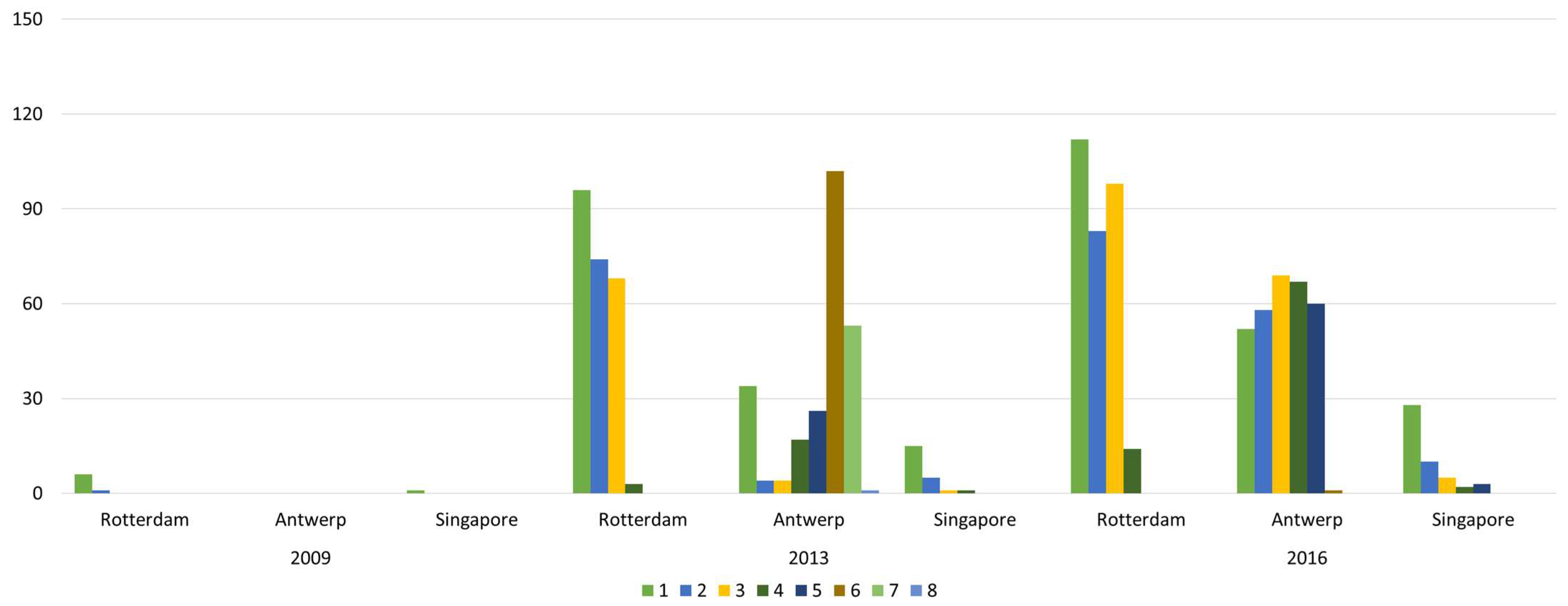
4.2. Ports Maintain a Stable Influence
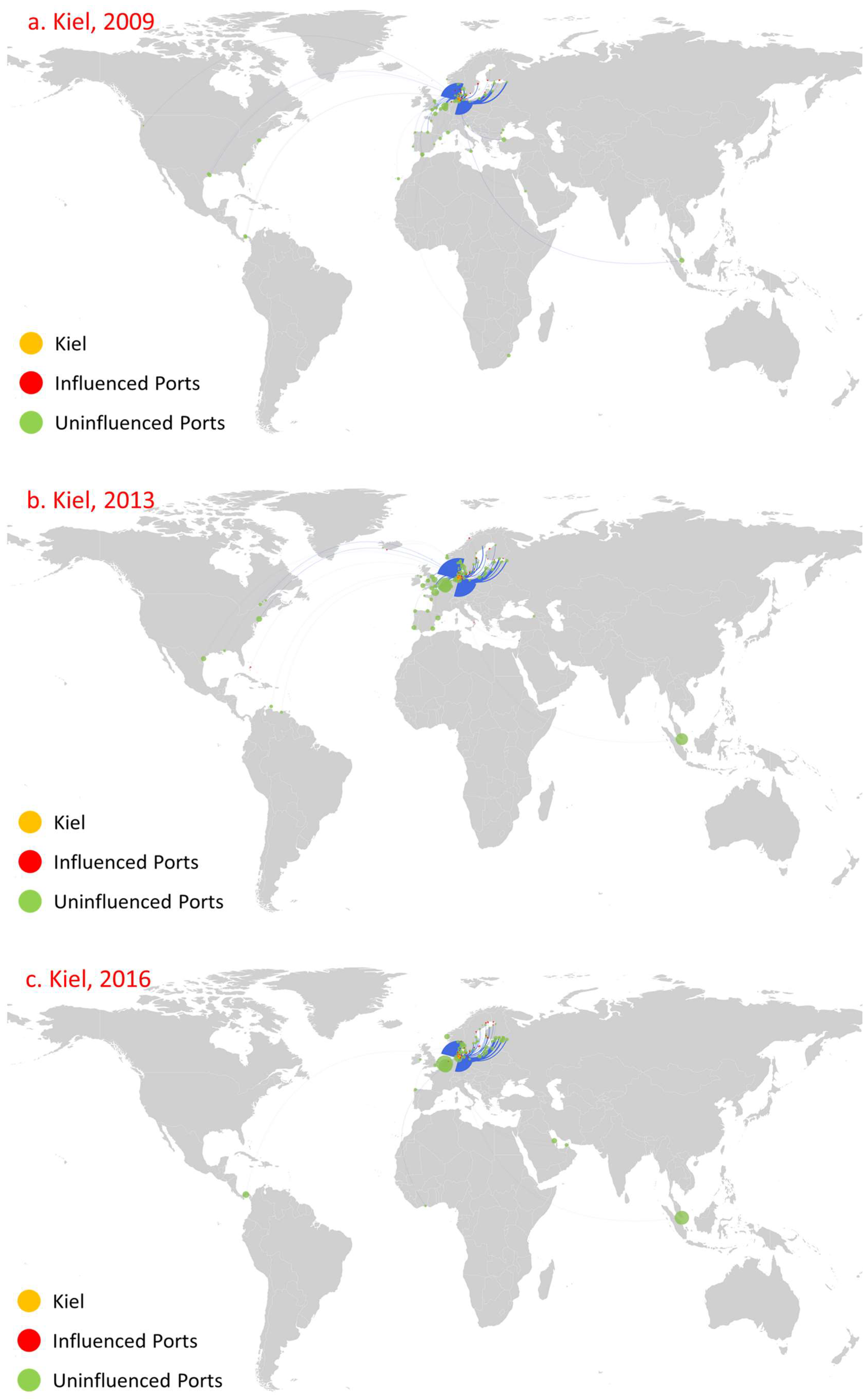


4.3. Ports with Phased Influence Change
4.4. Ports with Little Influence but Rapid Growth
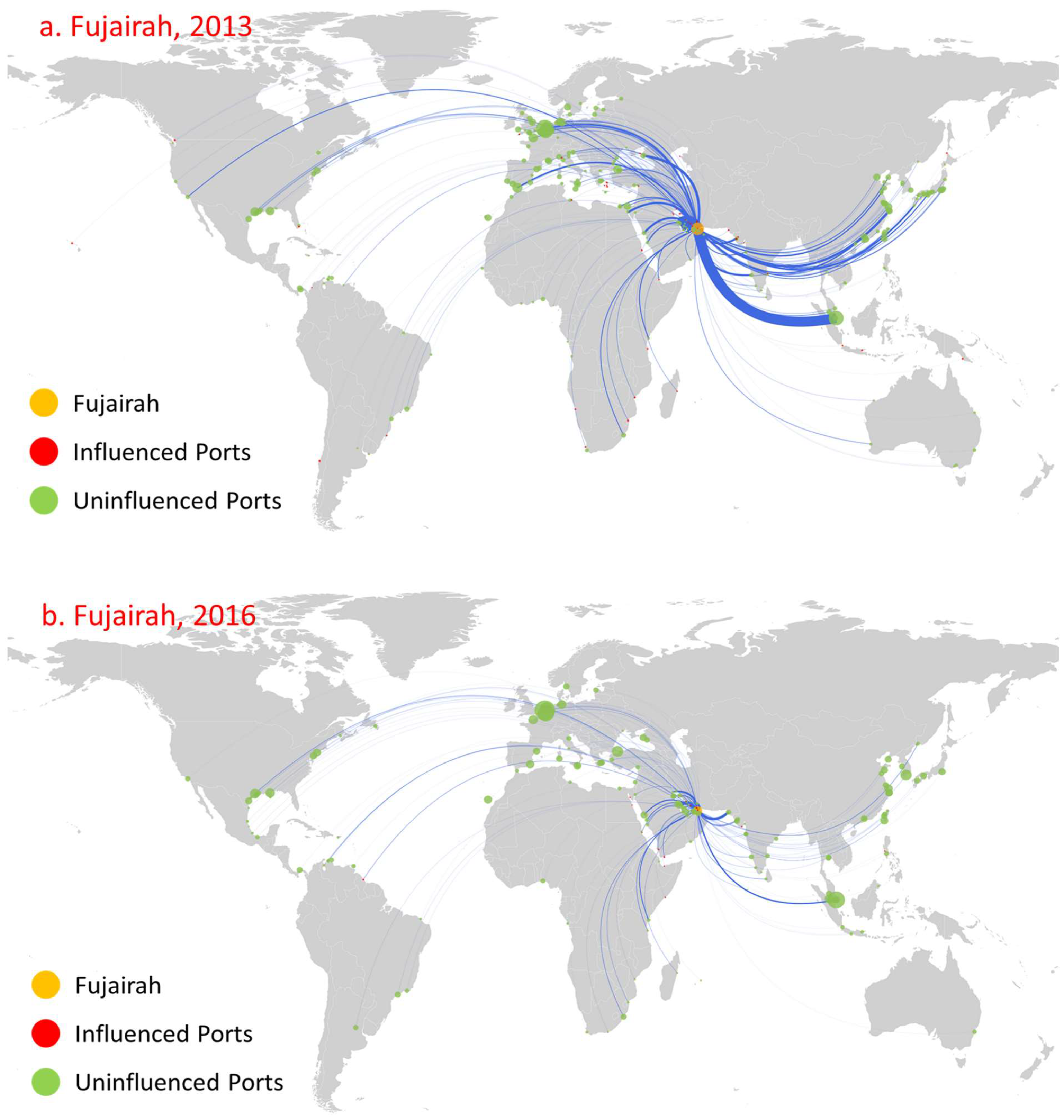

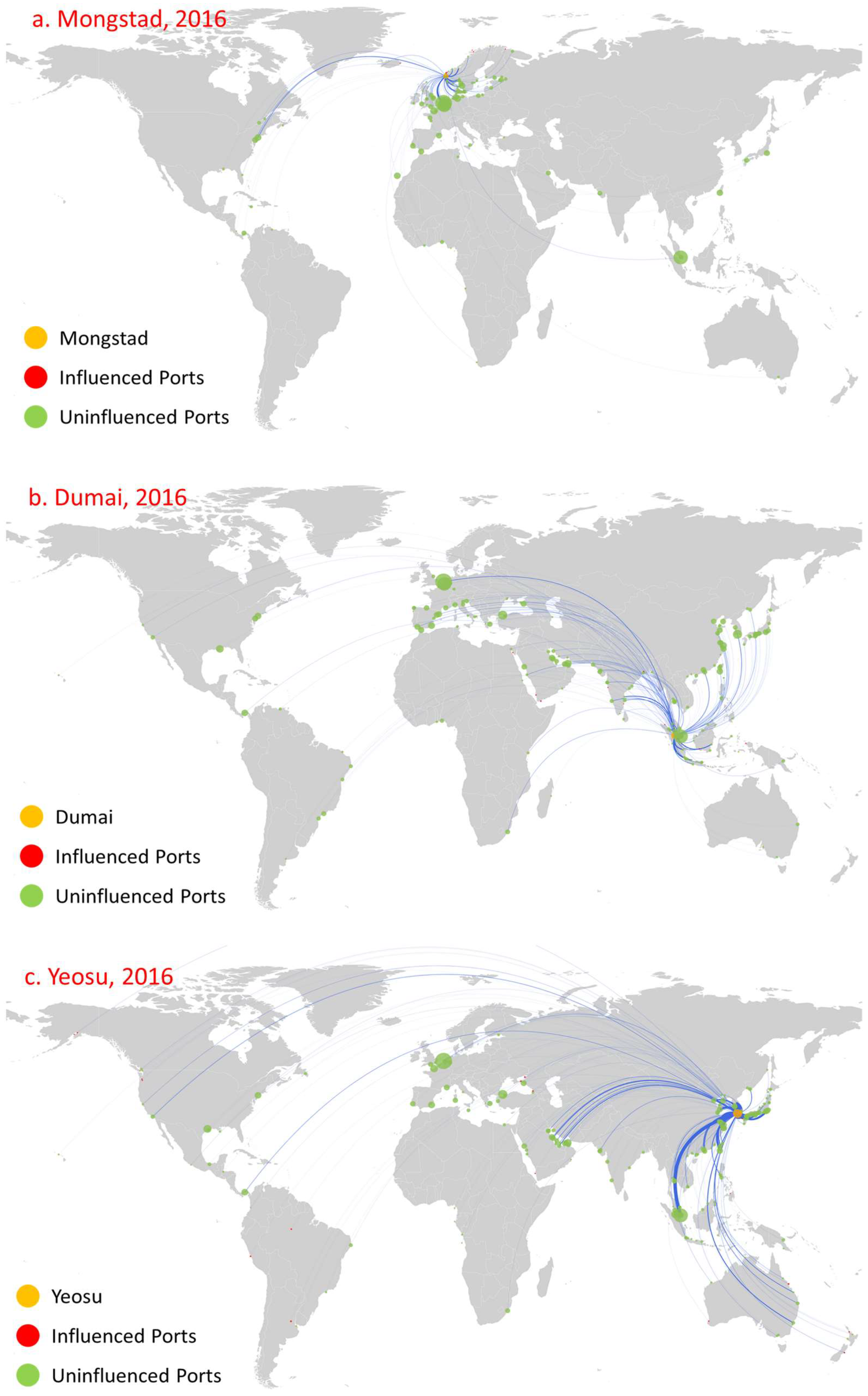
5. Discussion and Conclusions
Author Contributions
Funding
Acknowledgments
Conflicts of Interest
References
- Xu, M.; Pan, Q.; Muscoloni, A.; Xia, H.; Cannistraci, C.V. Modular gateway-ness connectivity and structural core organization in maritime network science. Nat. Commun. 2020, 11, 2849. [Google Scholar] [CrossRef] [PubMed]
- Baştuğ, S.; Haralambides, H.; Esmer, S.; Eminoğlu, E. Port competitiveness: Do container terminal operators and liner shipping companies see eye to eye? Mar. Policy 2022, 135, 104866. [Google Scholar] [CrossRef]
- Dulebenets, M.A. Multi-objective collaborative agreements amongst shipping lines and marine terminal operators for sustainable and environmental-friendly ship schedule design. J. Clean. Prod. 2022, 342, 130897. [Google Scholar] [CrossRef]
- Ducruet, C. Multilayer dynamics of complex spatial networks: The case of global maritime flows (1977–2008). J. Transp. Geogr. 2017, 60, 47–58. [Google Scholar] [CrossRef] [Green Version]
- Perc, M. The Matthew effect in empirical data. J. R. Soc. Interface 2014, 11, 20140378. [Google Scholar] [CrossRef] [Green Version]
- Elmi, Z.; Singh, P.; Meriga, V.K.; Goniewicz, K.; Borowska-Stefańska, M.; Wiśniewski, S.; Dulebenets, M.A. Uncertainties in Liner Shipping and Ship Schedule Recovery: A State-of-the-Art Review. J. Mar. Sci. Eng. 2022, 10, 563. [Google Scholar] [CrossRef]
- Kempe, D.; Kleinberg, J.; Tardos, É. Maximizing the Spread of Influence through a Social Network. In Proceedings of the Ninth ACM SIGKDD International Conference on Knowledge Discovery and Data Mining, Washington, DC, USA, 27 August 2003; ACM: New York, NY, USA, 2003; pp. 137–146. [Google Scholar]
- Bharathi, S.; Kempe, D.; Salek, M. Competitive Influence Maximization in Social Networks. In Proceedings of the International Workshop on Web and Internet Economics, San Diego, CA, USA, 12–14 December 2007; Springer: Berlin/Heidelberg, Germany, 2007; pp. 306–311. [Google Scholar]
- Peng, P.; Poon, J.P.; Yang, Y.; Lu, F.; Cheng, S. Global oil traffic network and diffusion of influence among ports using real time data. Energy 2019, 172, 333–342. [Google Scholar] [CrossRef]
- BP. BP Statistical Review of World Energy; BP Statistical Review: London, UK, 2018; Volume 6, p. 00116. [Google Scholar]
- Kaluza, P.; Kölzsch, A.; Gastner, M.; Blasius, B. The complex network of global cargo ship movements. J. R. Soc. Interface 2010, 7, 1093–1103. [Google Scholar] [CrossRef]
- Ducruet, C.; Notteboom, T. The worldwide maritime network of container shipping: Spatial structure and regional dynamics. Glob. Netw. 2012, 12, 395–423. [Google Scholar] [CrossRef] [Green Version]
- Li, Z.; Xu, M.; Shi, Y. Centrality in global shipping network basing on worldwide shipping areas. GeoJournal 2014, 80, 47–60. [Google Scholar] [CrossRef]
- Kosowska-Stamirowska, Z.; Ducruet, C.; Rai, N. Evolving structure of the maritime trade network: Evidence from the Lloyd’s Shipping Index (1890–2000). J. Shipp. Trade 2016, 1, 10. [Google Scholar] [CrossRef] [Green Version]
- Peng, P.; Cheng, S.; Chen, J.; Liao, M.; Wu, L.; Liu, X.; Lu, F. A fine-grained perspective on the robustness of global cargo ship transportation networks. J. Geogr. Sci. 2018, 28, 881–889. [Google Scholar] [CrossRef] [Green Version]
- Peng, P.; Cheng, S.; Lu, F. Characterizing the global liquefied petroleum gas trading community using mass vessel trajectory data. J. Clean. Prod. 2020, 252, 119883. [Google Scholar] [CrossRef]
- Peng, P.; Lu, F.; Cheng, S.; Yang, Y. Mapping the global liquefied natural gas trade network: A perspective of maritime transportation. J. Clean. Prod. 2020, 283, 124640. [Google Scholar] [CrossRef]
- Mou, N.; Liu, C.; Zhang, L.; Fu, X.; Xie, Y.; Li, Y.; Peng, P. Spatial Pattern and Regional Relevance Analysis of the Maritime Silk Road Shipping Network. Sustainability 2018, 10, 977. [Google Scholar] [CrossRef] [Green Version]
- Del Mondo, G.; Peng, P.; Gensel, J.; Claramunt, C.; Lu, F. Leveraging Spatio-Temporal Graphs and Knowledge Graphs: Perspectives in the Field of Maritime Transportation. ISPRS Int. J. Geo-Inf. 2021, 10, 541. [Google Scholar] [CrossRef]
- Li, Y.; Chen, W.; Wang, Y.; Zhang, Z.-L. Influence diffusion dynamics and influence maximization in social networks with friend and foe relationships. In Proceedings of the Sixth ACM International Conference on Web Search and Data Mining, Rome, Italy, 4–8 February 2013; ACM: New York, NY, USA, 2013; pp. 657–666. [Google Scholar]
- Aslay, C.; Lakshmanan, L.V.; Lu, W.; Xiao, X. Influence maximization in online social networks. In Proceedings of the Eleventh ACM International Conference on Web Search and Data Mining, Los Angeles, CA, USA, 5–9 February 2018; ACM: New York, NY, USA, 2018; pp. 775–776. [Google Scholar]
- Zeng, Q.; Zhong, M.; Zhu, Y.; Qian, T.; Li, J. Business location planning based on a novel geo-social influence diffusion model. Inf. Sci. 2021, 559, 61–74. [Google Scholar] [CrossRef]
- Bouyer, A.; Beni, H.A.; Arasteh, B.; Aghaee, Z.; Ghanbarzadeh, R. FIP: A fast overlapping community-based Influence Maximization Algorithm using probability coefficient of global diffusion in social networks. Expert Syst. Appl. 2022, 213, 118869. [Google Scholar] [CrossRef]
- Hinz, O.; Skiera, B.; Barrot, C.; Becker, J. Seeding Strategies for Viral Marketing: An Empirical Comparison. J. Mark. 2011, 75, 55–71. [Google Scholar] [CrossRef] [Green Version]
- Moscato, V.; Sperlì, G. A novel influence diffusion model under temporal and content constraints on Business Social Network. Telemat. Inform. 2022, 68, 101768. [Google Scholar] [CrossRef]
- Li, W.; Tang, S.; Pei, S.; Yan, S.; Jiang, S.; Teng, X.; Zheng, Z. The rumor diffusion process with emerging independent spreaders in complex networks. Phys. A Stat. Mech. Its Appl. 2014, 397, 121–128. [Google Scholar] [CrossRef]
- Zhou, J.; Liu, Z.; Li, B. Influence of network structure on rumor propagation. Phys. Lett. A 2007, 368, 458–463. [Google Scholar] [CrossRef]
- Zhu, L.; Yang, F.; Guan, G.; Zhang, Z. Modeling the dynamics of rumor diffusion over complex networks. Inf. Sci. 2021, 562, 240–258. [Google Scholar] [CrossRef]
- Li, Y.; Zhang, D.; Tan, K.-L. Real-time targeted influence maximization for online advertisements. Proc. VLDB Endow. 2015, 8, 1070–1081. [Google Scholar] [CrossRef] [Green Version]
- Bakshy, E.; Eckles, D.; Yan, R.; Rosenn, I. Social influence in social advertising: Evidence from field experiments. In Proceedings of the 13th ACM Conference on Electronic Commerce, Valencia, Spain, 4–8 June 2012; ACM: New York, NY, USA, 2012; pp. 146–161. [Google Scholar]
- Li, Y.-M.; Shiu, Y.-L. A diffusion mechanism for social advertising over microblogs. Decis. Support Syst. 2012, 54, 9–22. [Google Scholar] [CrossRef]
- Chen, W.; Yuan, Y.; Zhang, L. Scalable influence maximization in social networks under the linear threshold model. In Proceedings of the 2010 IEEE International Conference on Data Mining, Sydney, NSW, Australia, 13–17 December 2010; IEEE: Piscataway, NJ, USA, 2010; pp. 88–97. [Google Scholar]
- Li, Y.; Fan, J.; Wang, Y.; Tan, K.-L. Influence Maximization on Social Graphs: A Survey. IEEE Trans. Knowl. Data Eng. 2018, 30, 1852–1872. [Google Scholar] [CrossRef]
- Tang, Y.; Xiao, X.; Shi, Y. Influence maximization: Near-optimal time complexity meets practical efficiency. In Proceedings of the 2014 ACM SIGMOD International Conference on Management of Data, Snowbird, UT, USA, 22–27 June 2014; pp. 75–86. [Google Scholar]
- Lu, W.; Chen, W.; Lakshmanan, L.V. From competition to complementarity: Comparative influence diffusion and maximization. Proc. VLDB Endow. 2015, 9, 60–71. [Google Scholar] [CrossRef]
- Hosseinpour, M.; Malek, M.R.; Claramunt, C. Socio-spatial influence maximization in location-based social networks. Futur. Gener. Comput. Syst. 2019, 101, 304–314. [Google Scholar] [CrossRef]
- Ducruet, C. Network diversity and maritime flows. J. Transp. Geogr. 2013, 30, 77–88. [Google Scholar] [CrossRef] [Green Version]
- Peng, P.; Yang, Y.; Lu, F.; Cheng, S.; Mou, N.; Yang, R. Modelling the competitiveness of the ports along the Maritime Silk Road with big data. Transp. Res. Part A Policy Pr. 2018, 118, 852–867. [Google Scholar] [CrossRef]
- Zhang, L.; Meng, Q.; Fwa, T.F. Big AIS data based spatial-temporal analyses of ship traffic in Singapore port waters. Transp. Res. Part E Logist. Transp. Rev. 2019, 129, 287–304. [Google Scholar] [CrossRef]
- Regli, F.; Nomikos, N.K. The eye in the sky–Freight rate effects of tanker supply. Transp. Res. Part E Logist. Transp. Rev. 2019, 125, 402–424. [Google Scholar] [CrossRef]
- Ristic, B.; Scala, B.L.; Morelande, M.; Gordon, N. Statistical Analysis of Motion Patterns in AIS Data: Anomaly Detection and Motion Prediction. In Proceedings of the 2008 11th International Conference on Information Fusion, Cologne, Germany, 30 June–3 July 2008. [Google Scholar]
- Zhang, Y.; Li, W. Dynamic Maritime Traffic Pattern Recognition with Online Cleaning, Compression, Partition, and Clustering of AIS Data. Sensors 2022, 22, 6307. [Google Scholar] [CrossRef] [PubMed]
- Merk, O.; Notteboom, T. The Competitiveness of Global Port-Cities: The Case of Rotterdam/Amsterdam, The Netherlands; OECD Publishing: Paris, France, 2013. [Google Scholar] [CrossRef]
- Doshi, T. Houston of Asia: The Singapore Petroleum Industry; Institute of Southeast Asian Studies: Singapore, 1989; Volume 100. [Google Scholar]
- Blomme, J. The Antwerp Port: Elements of Spatial Planning. In Struggling for Leadership: Antwerp-Rotterdam Port Competition between 1870–2000; Springer: Berlin/Heidelberg, Germany, 2003; pp. 161–168. [Google Scholar]
- Peng, P.; Yang, Y.; Cheng, S.; Lu, F.; Yuan, Z. Hub-and-spoke structure: Characterizing the global crude oil transport network with mass vessel trajectories. Energy 2019, 168, 966–974. [Google Scholar] [CrossRef]
- Zhao, P.J.; Lv, B. Port economy and its spatial effects: A case study on Rotterdam port, Netherlands. Hum. Geogr. 2005, 20, 108–111. [Google Scholar]
- BP. BP Statistical Review of World Energy; 44BP Statistical Review: London, UK, 2014. [Google Scholar]
- Reuters. South Korea Easing Rules at Oil Terminals in Effort to Become Trade Hub. Available online: https://www.reuters.com/article/southkorea-oilstorage/s-korea-easing-rules-at-oil-terminals-in-effort-to-become-trade-hub-idUSL4N1JY35N (accessed on 20 July 2017).
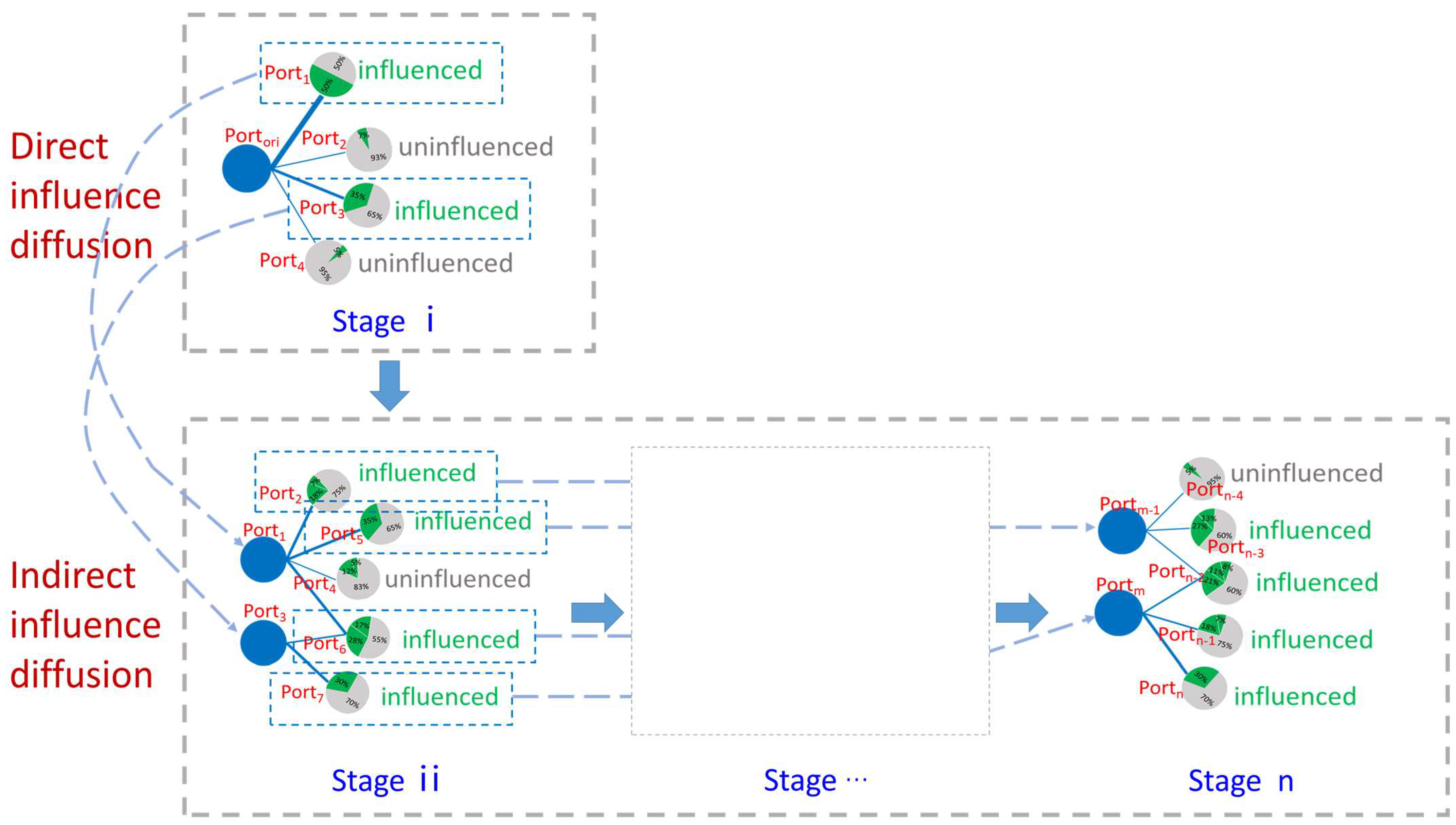
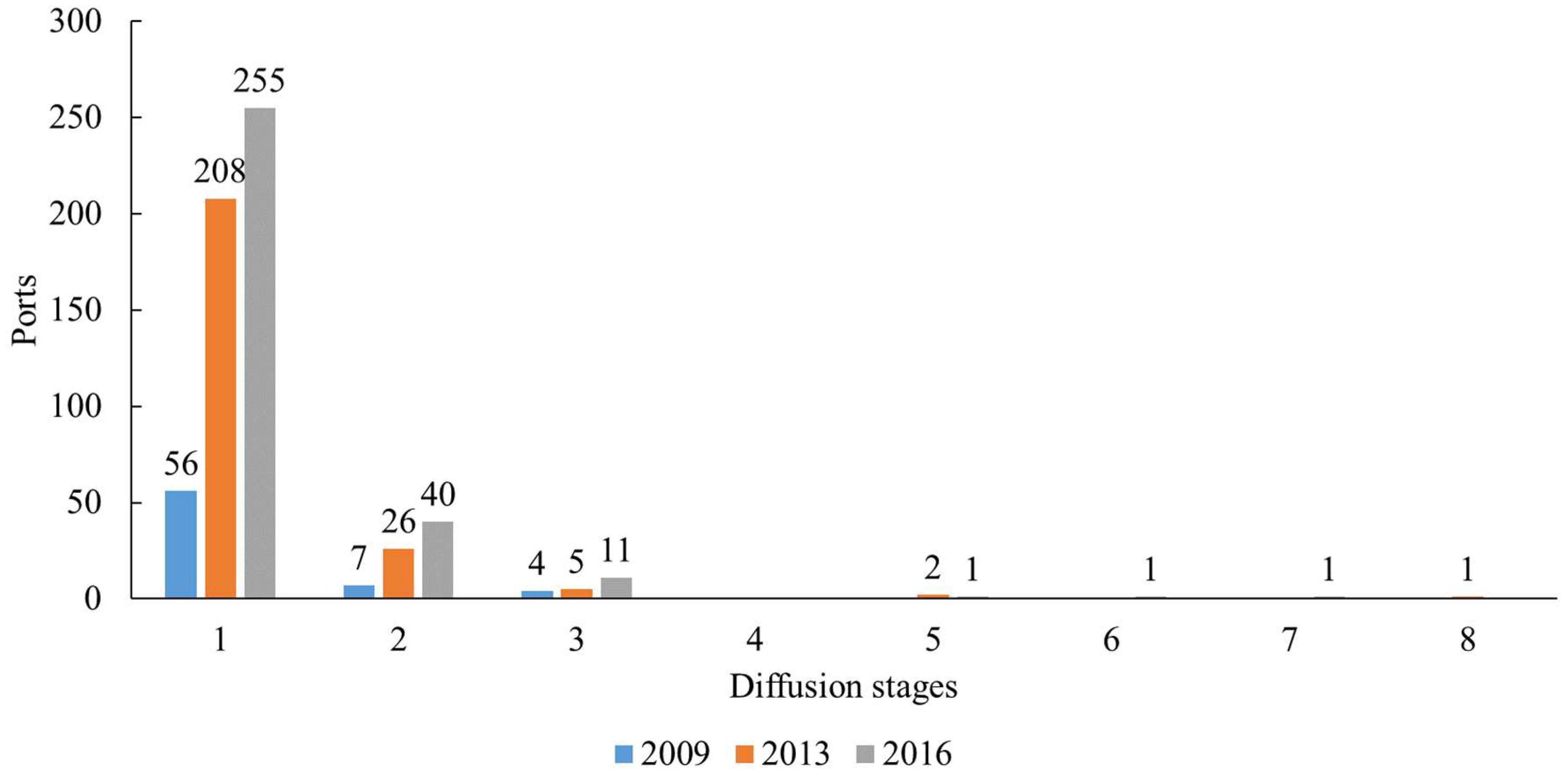
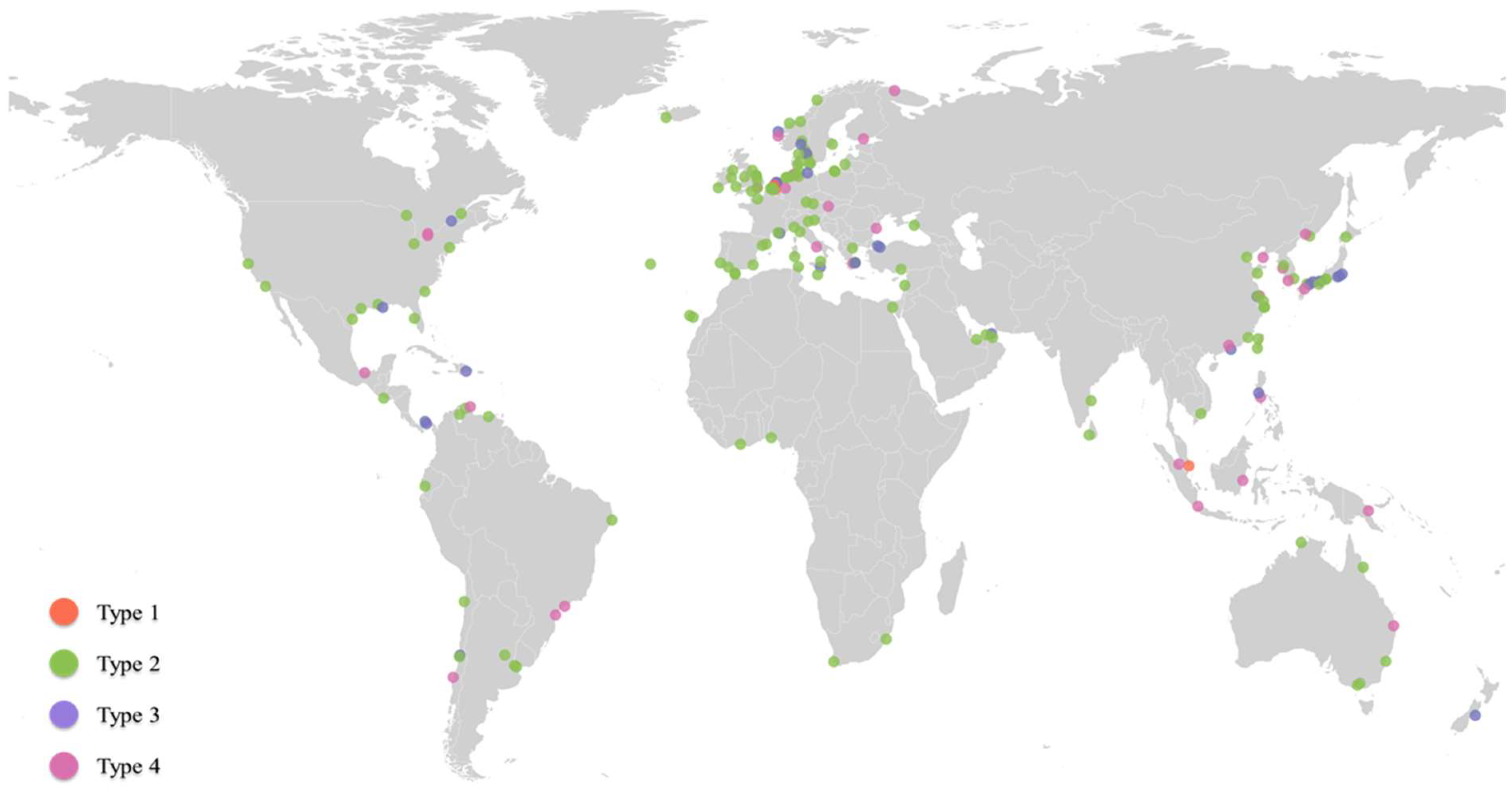
| MMSI | Update Time | Longitude | Latitude |
|---|---|---|---|
| 111111110 | 4 January 2016 21:03:49 | 118.6000 | 24.8333 |
| 111111110 | 13 January 2016 09:30:37 | 120.2333 | 31.9167 |
| 205073000 | 5 February 2016 08:19:50 | 56.3833 | 25.3500 |
| ··· | ··· | ··· | ··· |
Publisher’s Note: MDPI stays neutral with regard to jurisdictional claims in published maps and institutional affiliations. |
© 2022 by the authors. Licensee MDPI, Basel, Switzerland. This article is an open access article distributed under the terms and conditions of the Creative Commons Attribution (CC BY) license (https://creativecommons.org/licenses/by/4.0/).
Share and Cite
Peng, P.; Claramunt, C.; Cheng, S.; Lu, F. How Does a Port Build Influence? Diffusion Patterns in Global Oil Transportation. Sensors 2022, 22, 8595. https://doi.org/10.3390/s22228595
Peng P, Claramunt C, Cheng S, Lu F. How Does a Port Build Influence? Diffusion Patterns in Global Oil Transportation. Sensors. 2022; 22(22):8595. https://doi.org/10.3390/s22228595
Chicago/Turabian StylePeng, Peng, Christophe Claramunt, Shifen Cheng, and Feng Lu. 2022. "How Does a Port Build Influence? Diffusion Patterns in Global Oil Transportation" Sensors 22, no. 22: 8595. https://doi.org/10.3390/s22228595
APA StylePeng, P., Claramunt, C., Cheng, S., & Lu, F. (2022). How Does a Port Build Influence? Diffusion Patterns in Global Oil Transportation. Sensors, 22(22), 8595. https://doi.org/10.3390/s22228595









